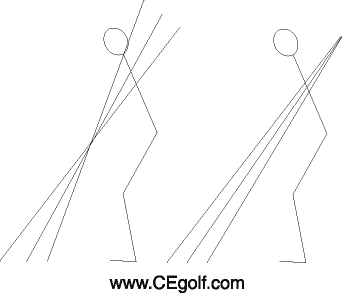
Swing Plane And
The Golf Swing
For anyone interested in the concept of swing plane, it is important to realize that there are swing types where swing plane is a crucial aspect of that swing, but there are other swing types where plane is inconsequential.
Also, when speaking of swing plane, it is the backswing plane and the initial transition into the forward swing that is relevant. Once the forward swing is underway, the clubhead has enough momentum that it pretty much stays in whatever plane it started in. That is why the transition is so important to all golfers, but especially for golfers who don't stay in a plane during the backswing. Golfers without a plane must get the club in plane—shaft oriented out toward the ball—as they transition into the forward swing in order to make the swing work properly.
For the rest of this page I'll be discussing swing plane as it relates to swing types where swing plane is a fundamental.
Ben Hogan didn't invent the golf swing plane concept, but he definitely popularized it. Hogan credited perfecting his swing plane as a major reason for his success. Of course, there were other key movements Hogan did that made him the best ball striker of all time, but plane allowed him to fine tune his backswing to near perfection.
In Ben Hogan's book Five Lessons, The Modern Fundamentals of Golf, there is a drawing of Hogan addressing a ball with an inclined pane of glass resting on his shoulders (his head sticks through a hole in the glass) and the inclined glass extends down to the ball. The purpose of the illustration was to show the ideal path for the clubhead, and Hogan believed that if the clubhead were to stay in that swing plane going back, a golfer's consistency could improve greatly.
A correct, or consistent, swing plane is the result of certain backswing mechanics, primarily arm rotation and shoulder turn, and depending on the particular type of swing and the golfer's physique, the plane may be anywhere from a flat swing plane to a somewhat upright swing plane. The key when swing plane is considered is that the clubhead stay close to a single plane as it moves through the backswing.
Some instructors confuse the issue of plane by introducing extraneous swing plane concepts by speaking of such things as the left arm and its relation to plane or they mention shaft plane at address, to name two, but the only thing that matters is that a plane is 2 dimensional, yet our bodies swing in 3 dimensions. This means that only one thing can continually be in plane, and that is the clubhead. Therefore, it is the path of the clubhead, and only that path, that determines if a golfer is swinging in plane.
Most people familiar with the concept of swing plane realize that an individual's plane gets flatter with a longer shaft and more upright with a shorter shaft, but not many know that the golfer's actual position at the top of the backswing should remain pretty much the same, regardless of what club is being used. Below I appeal to your artistic sense with my exquisite armless stick drawings. The one on the right is the way it should be.

If you're having trouble with the navigaton bar (left), try the CEGolf.com Contents page.
Casey Eberting Golf Instruction
©Copyright 1997-2024, All Rights Reserved